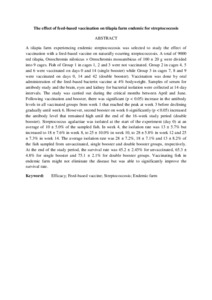Citation
Ismail, M. S. and Syafiq, M. R. and Siti-Zahrah, A. and Fahmi, S. and Shahidan, H. and Hanan, Y. and Amal, M. N. A. and Saad, M. Zamri
(2017)
The effect of feed-based vaccination on tilapia farm endemic for streptococcosis.
Fish & Shellfish Immunology, 60 (1).
pp. 21-24.
ISSN 1050-4648; ESSN: 1095-9947
Abstract
A tilapia farm experiencing endemic streptococcosis was selected to study the effect of vaccination with a feed-based vaccine on naturally ocurring streptococcosis. A total of 9000 red tilapia, Oreochromis niloticus × Oreochromis mossambicus of 100 ± 20 g were divided into 9 cages. Fish of Group 1 in cages 1, 2 and 3 were not vaccinated. Group 2 in cages 4, 5 and 6 were vaccinated on days 0 and 14 (single booster) while Group 3 in cages 7, 8 and 9 were vaccinated on days 0, 14 and 42 (double booster). Vaccination was done by oral administration of the feed-based bacterin vaccine at 4% bodyweight. Samples of serum for antibody study and the brain, eyes and kidney for bacterial isolation were collected at 14-day intervals. The study was carried out during the critical months between April and June. Following vaccination and booster, there was significant (p < 0.05) increase in the antibody levels in all vaccinated groups from week 1 that reached the peak at week 3 before declining gradually until week 6. However, second booster on week 6 significantly (p < 0.05) increased the antibody level that remained high until the end of the 16-week study period (double booster). Streptococcus agalactiae was isolated at the start of the experiment (day 0) at an average of 10 ± 5.0% of the sampled fish. In week 4, the isolation rate was 13 ± 5.7% but increased to 18 ± 7.6% in week 8, to 25 ± 10.0% in week 10, to 28 ± 5.8% in week 12 and 25 ± 7.3% in week 14. The average isolation rate was 28 ± 7.2%, 18 ± 7.1% and 13 ± 8.2% of the fish sampled from unvaccinated, single booster and double booster groups, respectively. At the end of the study period, the survival rate was 45.2 ± 2.45% for unvaccinated, 65.3 ± 4.8% for single booster and 75.1 ± 2.1% for double booster groups. Vaccinating fish in endemic farm might not eliminate the disease but was able to significantly improve the survival rate.
Download File
![[img]](http://psasir.upm.edu.my/63429/1.hassmallThumbnailVersion/The%20effect%20of%20feed-based%20vaccination%20on%20tilapia%20farm%20endemic%20for%20streptococcosis.pdf)  Preview |
|
Text (Abstract)
The effect of feed-based vaccination on tilapia farm endemic for streptococcosis.pdf
Download (6kB)
| Preview
|
|
Additional Metadata
Actions (login required)
 |
View Item |

